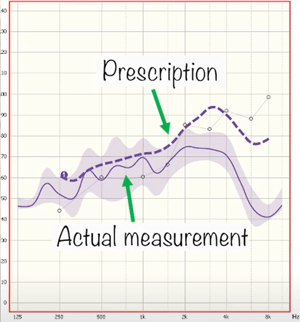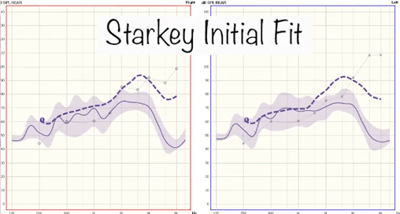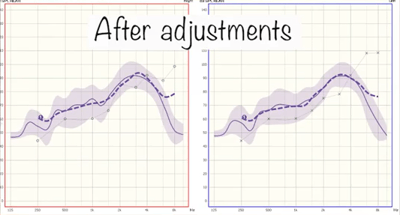Time to Read: 12 minutes
A Starkey Livio Custom Rechargeable hearing aid is fitted to our client, Fred. She discusses the hearing aid fitting appointment, the challenges that may arise, and the importance of Real Ear Measurements (REM).
This is the second in the series:
Hi there, welcome back to Value Hearing's YouTube channel.
I am Emma, a clinical audiologist. In today's video I'm going to show you what happens during the fitting of a hearing aid at Value Hearing.
We won't go into lots of detail but we're just going to give you a bit of an example of what happens specifically actually when you get a custom hearing aid fitted. The client I'm speaking of is actually Fred, who you may have met a few weeks ago in one of our earlier YouTube channel videos where I got very excited about fitting the first custom rechargeable hearing aid in the world and lovely Fred was willing to let me record him .
What this video will show you is some of the steps that we take when we fit that hearing aid. We do have another video coming that will go through what Fred felt, and how he's responded, and how he's coping with his new hearing aids - a bit of a follow-up.
What happens in a fitting appointment?
Today's video is really to show you, as I promised, what happens in one of these appointments so I won't go on about it too long.
Generally what we do when we have a customized hearing aid like that the most important thing initially is making sure that it does fit the ear very well so we do take impressions of the ear and we send them off to the hearing aid manufacturer but it doesn't always come back perfect. It depends on the ear, the person designing it, and very much on the manufacturer as well.
Luckily here in Australia, and I believe it's actually overseas where a lot of it happens, with Starkey we generally get very well fitting customized hearing aids back. That's one of the reasons why we do choose Starkey quite a lot for customized hearing aids.
Fred's thankfully came back fitting really really well. I was concerned that it would be difficult for him to get them in and out of his ears with his limited dexterity but they're so well designed, they fit comfortably for him.
Something that we can't always tell straight away but what we can find out after a few weeks, is if they have good retention - so if they stay in the ear, or is it a case of when he talks and chews, does the hearing aid work its way out and that's fairly common, very fixable but fairly common. Thankfully for Fred, he says he puts them in in the morning leaves them there all day and completely forgets about them - no discomfort, no itchiness, and certainly they seem to stay put so that's been really good.
The importance of Real Ear Measurement
 The next thing we do in a fitting appointment is we do something called a Real Ear Measurement so what this is, is basically just making sure that the hearing aids are prescribed appropriately for our clients.
The next thing we do in a fitting appointment is we do something called a Real Ear Measurement so what this is, is basically just making sure that the hearing aids are prescribed appropriately for our clients.
So when we enter the audiogram into the software for the hearing aids, there is what we'd call a pre-calculation. So in this case Starkey would have calculated based on Fred and his hearing loss generally. What kind of prescription he needed in order to achieve something close to normal hearing volumes for speech. Sometimes it's pretty spot on, but sometimes we do the Real Ear Measurement and we look at how the hearing aids are prescribed and we realize they're not quite prescribed as well as they could be.
This can be for some manufacturers they're just not as good as getting at getting their prescription accurate, sometimes it's just that ear is very different from average in terms of the acoustics of that ear and this size, and shape, and elasticity, and all sorts of things that can have an impact on that. Sometimes it's the fit of the hearing aid as well that's slightly different to where Starkey or the hearing aid manufacturer would have imagined it would be.
 So we really do need to do these Real Ear Measurements to make sure that the hearing aids are doing what they say they are on screen, and that they're prescribed as well as possible. Obviously it is just a prescription so we do ask our clients how it sounds.
So we really do need to do these Real Ear Measurements to make sure that the hearing aids are doing what they say they are on screen, and that they're prescribed as well as possible. Obviously it is just a prescription so we do ask our clients how it sounds.
We make sure they're comfortable and clear, and that they like the sound quality but the evidence is very, very strong, very, very strong that a Real Ear Measurement can take you from hearing fairly well, and being quite happy with your hearing aids to getting the absolute most out of them and really noticing a great benefit.
You'll see with these examples, basically with this Real Ear Measurement with this equipment that I'm using, we want the thin line to match the dark thick dash line as closely as possible. As you look at the screen going from left to right, that is going from the very low deep frequencies of speech, across to the higher pitched frequencies of speech so bass across to treble, from left to right.
Ideally for Fred to hear all of the speech frequencies as well as someone with normal hearing, we need to have that thin line matching the dark thick dashed line as well as possible.
 Now I have to say, that when I fit Starkey often they actually are very close to target so I will often run this test and I have to make very minimal tweaking to get it right for the client when compared to some other manufacturers.
Now I have to say, that when I fit Starkey often they actually are very close to target so I will often run this test and I have to make very minimal tweaking to get it right for the client when compared to some other manufacturers.
In Fred's case however, it was actually quite well off. As you can see from this screen, you'll see that this is actually full prescription from Starkey and this thin line is matching fairly well in the low frequencies for Fred, but not really matching at all in the high frequencies for Fred.
So if I'd sent Fred off with this prescription, he would have been reporting a lack of clarity in speech. He may have noticed some improvement, of course, but unlikely that he would report a significant improvement with this.
It did take a little bit of time, but I managed to get it to match this well. As you can see we've now got these two lines meeting much, much more closely across the speech spectrum. There is a bit of a roll-off which is what we expect. I won't go into the psychoacoustics of this
but this is generally what we do expect in most human ears, but up until this point we've got a lovely match and this is what we would consider a very, very good match to target.
Getting used to 'new' sounds
Note that does not mean that Fred left with that exact match, just simply because Fred hasn't had hearing aids before that were consistently worn so we just reduced it a little bit to make sure in terms of overall gain that Fred was comfortable. We did push him a little bit, he definitely reported after two weeks the world's very noisy.
He would not stop talking about his squeaky wooden floor but after another two weeks, Fred actually really started to adjust and still notice the background noise, but it wasn't bothering him quite as much.
Obviously a big part of the initial fitting appointment as well is when we show our client, Fred in this case, how to clean the hearing aids and use them at their best and manage them.
Getting used to managing new aids
So with Fred it was going through how to charge them, how to change their wax filters, how to clean their microphones and microphone covers, how to maintain them and how to get them in and out of his ears, which is some of the biggest challenges for people to get used to when they haven't had this type of hearing aid or any hearing aid at all.
A good chunk of the appointment is counselling and really showing people how to be confident in using their new hearing devices. Sometimes we don't do all of this in the first appointment. We might take it slowly, because it can be a lot of information in one go.
Sometimes we'll prioritise what needs to be taught in that first appointment and certainly the follow-ups are extremely important in those first few weeks for some teething problems and reminders and hands-on practice and all the different bits and pieces that come with the hearing aids.
So, a lot of hands-on practice happens in those first few appointments when we have someone who's very new to hearing aids, or even just transferring from one type or one
manufacturer of hearing aid to another, a lot of time is spent in the appointment counselling people on what to expect, counselling them on how to optimise the hearing technology.
The hearing aids can't do everything, there's a lot more to it in terms of communication skills. We'll spend a good bit of time talking about that with the client with their individual situation and the individuals that exist in their life, and how to communicate best.
I hope that answered some questions you may have had about what exactly happens during a hearing aid fitting appointment. Like I said earlier in a few weeks we'll have an even more interesting video on how Fred is actually coping with his new hearing aids, how he's handling them and how he's hearing with them.